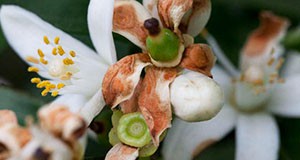
This two-sided ID card is idea for growers working in the field trying to identify or manage postbloom fruit drop (PFD) in citrus. The ID card includes photos of blooms affected by PFD and photos of healthy blooms for comparison. The card also includes facts and tips for managing PFD. Written by Megan M. Dewdney, Natalia A. Peres, and Jamie D. Burrow, and published by the UF Department of Plant Pathology, July 2015.
http://edis.ifas.ufl.edu/pp318
Tag: Plant Pathology Department
Rose Rosette Disease: A New Disease of Roses in Florida
Rose rosette disease is an incurable, destructive disease that affects both wild and cultivated roses. Over the past several decades, the disease has spread over much of the U.S., though it was first observed in Florida in 2013. This 6-page fact sheet describes the symptoms and diagnosis of the disease, as well as the cultural, chemical, and, possibly, biological controls that can minimize its spread. Written by Binoy Babu, Mathews L. Paret, Tim Schubert, Carlye Baker, Gary Knox, Fanny Iriarte, James Aldrich, Laura Ritchie, Carrie L. Harmon, and Svetlana Y. Folimonova, and published by the UF Department of Plant Pathology, May 2015.
http://edis.ifas.ufl.edu/pp317
Pest Management of Peppers in Miami-Dade County, Florida
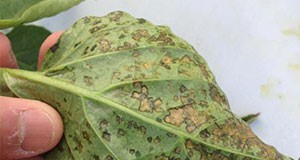
Pest management of peppers in Miami-Dade County is challenging because of a climate favorable to pests. To assist local pepper growers in maintaining crop productivity and improving the quality of produce, this publication illustrates common pests including major diseases and insects and recommends Integrated Pest Management (IPM) techniques, including host resistance, cultivation, sanitation, and physical, mechanical, biological, and chemical approaches, for effective pest management. This 8-page fact sheet was written by Qingren Wang, Shouan Zhang, Dakshina Seal, and Teresa Olczyk, and published by the UF Department of Plant Pathology, February 2015. (Photo: Shouan Zhang)
http://edis.ifas.ufl.edu/pp316
Mosaic Disease of St. Augustinegrass caused by Sugarcane Mosaic Virus
 Mosaic disease of St. Augustinegrass was first reported in the 1960s in sugarcane producing areas of Palm Beach County, Florida. In the 10 years prior to 2013, less than 5 samples with mild symptoms were brought to the attention of the extension turfgrass pathologist. But in September 2013, an outbreak of the disease occurred in Pinellas County. Leaf symptoms included mosaic, but turned necrotic and the severe dieback that completely killed some infected lawns. In September 2014, lawns infected in 2013 and new lawns started dying in both Pinellas and Palm Beach Counties. Despite the similarity of symptoms to another St. Augustinegrass decline (SAD), as of November 2014, all samples have tested negative for SAD, and positive for presence of Sugarcane Mosaic Virus. This 3-page fact sheet was written by Phil Harmon, and published by the UF Department of Plant Pathology, November 2014.
Mosaic disease of St. Augustinegrass was first reported in the 1960s in sugarcane producing areas of Palm Beach County, Florida. In the 10 years prior to 2013, less than 5 samples with mild symptoms were brought to the attention of the extension turfgrass pathologist. But in September 2013, an outbreak of the disease occurred in Pinellas County. Leaf symptoms included mosaic, but turned necrotic and the severe dieback that completely killed some infected lawns. In September 2014, lawns infected in 2013 and new lawns started dying in both Pinellas and Palm Beach Counties. Despite the similarity of symptoms to another St. Augustinegrass decline (SAD), as of November 2014, all samples have tested negative for SAD, and positive for presence of Sugarcane Mosaic Virus. This 3-page fact sheet was written by Phil Harmon, and published by the UF Department of Plant Pathology, November 2014.
http://edis.ifas.ufl.edu/pp313
Mancha foliar causada por Xanthomonas en Ficus elastica
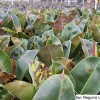 En verano del 2010, en viveros de Homestead se reportaron casos de Ficus elastica con manchas foliares circulares que se asemejan a los síntomas causados por la bacteria fitopatógena Xanthomonas campestris pv fici, aún no reportada en Ficus elastica. El daño severo affectó a la mayoría de los productores comerciales del sur de la Florida. This is the Spanish language version of Bacterial Blight of Ficus elastic Caused by Xanthomonas (PP305). This 3-page fact sheet was written by E. V. Campoverde, A. J. Palmateer, and P. Lopez, and published by the UF Department of Plant Pathology, July 2014.
En verano del 2010, en viveros de Homestead se reportaron casos de Ficus elastica con manchas foliares circulares que se asemejan a los síntomas causados por la bacteria fitopatógena Xanthomonas campestris pv fici, aún no reportada en Ficus elastica. El daño severo affectó a la mayoría de los productores comerciales del sur de la Florida. This is the Spanish language version of Bacterial Blight of Ficus elastic Caused by Xanthomonas (PP305). This 3-page fact sheet was written by E. V. Campoverde, A. J. Palmateer, and P. Lopez, and published by the UF Department of Plant Pathology, July 2014.
http://edis.ifas.ufl.edu/pp312
Management of Powdery Mildew in Beans
 Powdery mildew is one of the most commonly occurring diseases on many types of beans. Although the causal organism rarely causes extensive damage, significant yield losses were reported in Columbia County when infection occurred in dry beans prior to flowering. Accurately identifying this disease and immediately taking action for control are critical to effectively prevent spread of powdery mildew in order to reduce significant losses of yield and quality. This 4-page fact sheet was written by Qingren Wang, Shouan Zhang, and Teresa Olczyk, and published by the UF Department of Plant Pathology, June 2014.
Powdery mildew is one of the most commonly occurring diseases on many types of beans. Although the causal organism rarely causes extensive damage, significant yield losses were reported in Columbia County when infection occurred in dry beans prior to flowering. Accurately identifying this disease and immediately taking action for control are critical to effectively prevent spread of powdery mildew in order to reduce significant losses of yield and quality. This 4-page fact sheet was written by Qingren Wang, Shouan Zhang, and Teresa Olczyk, and published by the UF Department of Plant Pathology, June 2014.
http://edis.ifas.ufl.edu/pp311
2013 Evaluation of In-Furrow and Foliar Fungicides for Disease Control in Peanut in Jay, Florida
 This 10-page fact sheet summarizes the 2013 in-furrow and foliar fungicide programs for control of early and late leaf spot and white mold (southern stem rot) of peanut in Jay, Florida. It shows the effectiveness of 13 fungicide programs for disease control, as compared to no treatment. This data represents only one year and one location, and readers are cautioned that test results should be considered over several locations and years before final conclusions are valid. Written by Darcy E. P. Telenko, John Atkins, and Nick Dufault, and published by the UF Department of Plant Pathology, January 2014.
This 10-page fact sheet summarizes the 2013 in-furrow and foliar fungicide programs for control of early and late leaf spot and white mold (southern stem rot) of peanut in Jay, Florida. It shows the effectiveness of 13 fungicide programs for disease control, as compared to no treatment. This data represents only one year and one location, and readers are cautioned that test results should be considered over several locations and years before final conclusions are valid. Written by Darcy E. P. Telenko, John Atkins, and Nick Dufault, and published by the UF Department of Plant Pathology, January 2014.
http://edis.ifas.ufl.edu/pp310
Impatiens Downy Mildew
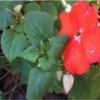 Downy mildew on impatiens is of great concern throughout Florida. Winters in south Florida provide high humidity paired with cool nights, creating ideal conditions for disease development. Downy mildews are caused by several different species of pathogens that tend to be plant-host specific. Plasmopara obducens is the pathogen that affects impatiens. Some literature indicates that nighttime temperatures of about 50 to 72°F favor downy mildew, but the disease has been reported on impatiens year round in south Florida. This 4-page fact sheet was written by L. Sanagorski, B. Schall, A.J. Palmateer, and N.A. Peres, and published by the UF Department of Plant Pathology, October 2013.
Downy mildew on impatiens is of great concern throughout Florida. Winters in south Florida provide high humidity paired with cool nights, creating ideal conditions for disease development. Downy mildews are caused by several different species of pathogens that tend to be plant-host specific. Plasmopara obducens is the pathogen that affects impatiens. Some literature indicates that nighttime temperatures of about 50 to 72°F favor downy mildew, but the disease has been reported on impatiens year round in south Florida. This 4-page fact sheet was written by L. Sanagorski, B. Schall, A.J. Palmateer, and N.A. Peres, and published by the UF Department of Plant Pathology, October 2013.
http://edis.ifas.ufl.edu/pp309
Ornamental Ficus Diseases: Identification and Control in Commercial Greenhouse Operations
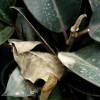 While edible figs are grown agronomically for delicious fruit, many Ficus species have been commercialized for decorative, ornamental purposes. These horticultural Ficus varieties are used for interiorscape houseplant décor and for outdoor landscape design. This article provides guidelines for the identification and treatment of diseases that may be encountered during the commercial production of ornamental Ficus. This 7-page fact sheet was written by D. J. Norman and Shad Ali, and published by the UF Department of Plant Pathology, August 2013.
While edible figs are grown agronomically for delicious fruit, many Ficus species have been commercialized for decorative, ornamental purposes. These horticultural Ficus varieties are used for interiorscape houseplant décor and for outdoor landscape design. This article provides guidelines for the identification and treatment of diseases that may be encountered during the commercial production of ornamental Ficus. This 7-page fact sheet was written by D. J. Norman and Shad Ali, and published by the UF Department of Plant Pathology, August 2013.
http://edis.ifas.ufl.edu/pp308
Tomato Chlorotic Spot Virus
 Tomato chlorotic spot virus (TCSV) is a tospovirus, similar to but distinct from other tospoviruses currently present in Florida. Like these viruses, TCSV is transmitted by thrips and is able to replicate in both the vector and the plant. TCSV was first reported in Florida in 2012 in tomato plants in Miami-Dade and Lee Counties, but it may have been in the state for several years. Prior to 2012, TCSV was only known to occur in Brazil and Argentina. It is not known how this virus was introduced into Florida. This 5-page fact sheet was written by Jane E. Polston, Erin Wood, Aaron J. Palmateer, and Shouan Zhang, and published by the UF Department of Plant Pathology, May 2013.
Tomato chlorotic spot virus (TCSV) is a tospovirus, similar to but distinct from other tospoviruses currently present in Florida. Like these viruses, TCSV is transmitted by thrips and is able to replicate in both the vector and the plant. TCSV was first reported in Florida in 2012 in tomato plants in Miami-Dade and Lee Counties, but it may have been in the state for several years. Prior to 2012, TCSV was only known to occur in Brazil and Argentina. It is not known how this virus was introduced into Florida. This 5-page fact sheet was written by Jane E. Polston, Erin Wood, Aaron J. Palmateer, and Shouan Zhang, and published by the UF Department of Plant Pathology, May 2013.
http://edis.ifas.ufl.edu/pp306
Disease Control for Florida Tomatoes (PPP35/VH056)
 Successful disease management has always been vital in Florida tomato production, given the generally ideal environmental conditions for most plant diseases. An integrated disease management program is a successful approach. This 7-page fact sheet was written by Mathews Paret, Ken Pernezny, and Pam Roberts, and published by the UF Department of Plant Pathology, August 2013.
Successful disease management has always been vital in Florida tomato production, given the generally ideal environmental conditions for most plant diseases. An integrated disease management program is a successful approach. This 7-page fact sheet was written by Mathews Paret, Ken Pernezny, and Pam Roberts, and published by the UF Department of Plant Pathology, August 2013.
http://edis.ifas.ufl.edu/vh056
Powdery Mildew of Strawberries (PP208/PP129)
 Powdery mildew occurs in most areas of the world where strawberries are grown, infecting leaves, flowers, and fruit. Infected transplants are normally the primary source of inoculum for fruiting fields in Florida, but even disease-free fields can become infected by conidia blown in from neighboring fields. Fields with susceptible cultivars should be surveyed regularly for powdery mildew, especially early in the season. Usually, controlling foliar infection helps to prevent fruit infection. This 4-page fact sheet was written by N. A. Peres and J. C. Mertely, and published by the UF Department of Plant Pathology, May 2013.
Powdery mildew occurs in most areas of the world where strawberries are grown, infecting leaves, flowers, and fruit. Infected transplants are normally the primary source of inoculum for fruiting fields in Florida, but even disease-free fields can become infected by conidia blown in from neighboring fields. Fields with susceptible cultivars should be surveyed regularly for powdery mildew, especially early in the season. Usually, controlling foliar infection helps to prevent fruit infection. This 4-page fact sheet was written by N. A. Peres and J. C. Mertely, and published by the UF Department of Plant Pathology, May 2013.
http://edis.ifas.ufl.edu/pp129
Bacterial Blight of Ficus elastica Caused by Xanthomonas (PP305)
 In the summer of 2010, leaf blight cases were reported on several Ficus elastica cultivars in Homestead nurseries. Symptoms somewhat resembled those caused by Xanthomonas campestris p.v. fici, but this pathogen has never been reported to occur on Ficus elastica. The outbreak was severe, and the majority of commercial producers in the southern portion of the state were affected. The widespread outbreak from 2010 to date has caused many nurseries to lose entire Ficus elastica crops. This 3-page fact sheet describes the symptoms and disease management recommendations. Written by E. V. Campoverde and A. J. Palmateer, and published by the UF Department of Plant Pathology, April 2013.
In the summer of 2010, leaf blight cases were reported on several Ficus elastica cultivars in Homestead nurseries. Symptoms somewhat resembled those caused by Xanthomonas campestris p.v. fici, but this pathogen has never been reported to occur on Ficus elastica. The outbreak was severe, and the majority of commercial producers in the southern portion of the state were affected. The widespread outbreak from 2010 to date has caused many nurseries to lose entire Ficus elastica crops. This 3-page fact sheet describes the symptoms and disease management recommendations. Written by E. V. Campoverde and A. J. Palmateer, and published by the UF Department of Plant Pathology, April 2013.
http://edis.ifas.ufl.edu/pp305
Sintomas de Cancro Citrico en Arboles de Vivero (PP307)
 This is a two-page illustrated identification sheet for citrus canker symptoms that appear in citrus nurseries. Written by Timothy D. Riley, Megan M. Dewdney, and Jamie D. Burrow, and published by the UF Department of Plant Pathology, May 2013.
This is a two-page illustrated identification sheet for citrus canker symptoms that appear in citrus nurseries. Written by Timothy D. Riley, Megan M. Dewdney, and Jamie D. Burrow, and published by the UF Department of Plant Pathology, May 2013.
http://edis.ifas.ufl.edu/pp307
Citrus Canker Symptoms on Nursery Trees (PP304)
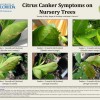 This document is a two-page illustrated identification sheet for citrus canker symptoms that appear in citrus nurseries. Written by Timothy D. Riley, Megan M. Dewdney, and Jamie D. Burrow, and published by the UF Department of Plant Pathology, April 2013.
This document is a two-page illustrated identification sheet for citrus canker symptoms that appear in citrus nurseries. Written by Timothy D. Riley, Megan M. Dewdney, and Jamie D. Burrow, and published by the UF Department of Plant Pathology, April 2013.
http://edis.ifas.ufl.edu/pp304
A Postharvest Fruit Rot Caused by Alternaria sp. on Imported Plum Tomatoes in South Florida (PP303)
 Florida’s deep-water ports are ideal for importing many fruits and vegetables, including tomatoes, by ship from the Caribbean as well as Central and South American production areas. These imports are often strictly regulated for pests, but some pathogens still escape quarantine. This 3-page fact sheet describes a postharvest problem on plum tomatoes that were imported from Mexico through South Florida in 2010. Alternaria sp. was isolated from lesions on diseased fruits, pathogenicity tests were conducted on healthy fruits, and symptoms identical to the originally submitted samples were developed. Written by Zelalem Mersha, Shouan Zhang,and Jerry A. Bartz, and published by the UF Department of Plant Pathology, January 2013.
Florida’s deep-water ports are ideal for importing many fruits and vegetables, including tomatoes, by ship from the Caribbean as well as Central and South American production areas. These imports are often strictly regulated for pests, but some pathogens still escape quarantine. This 3-page fact sheet describes a postharvest problem on plum tomatoes that were imported from Mexico through South Florida in 2010. Alternaria sp. was isolated from lesions on diseased fruits, pathogenicity tests were conducted on healthy fruits, and symptoms identical to the originally submitted samples were developed. Written by Zelalem Mersha, Shouan Zhang,and Jerry A. Bartz, and published by the UF Department of Plant Pathology, January 2013.
http://edis.ifas.ufl.edu/pp303
Calonectria (Cylindrocladium) Leaf Spot of Palm (PP302)
 Calonectria is a fungus that affects a large number of hosts worldwide, including timber and ornamental, agricultural, and horticultural crops, causing a wide range of disease symptoms, such as cutting rot, damping-off of seedlings, leaf spot, shoot blight, and root rot. This 4-page fact sheet was written by Jiaming Yu and Monica L. Elliott, and published by the UF Department of Plant Pathology, January 2013.
Calonectria is a fungus that affects a large number of hosts worldwide, including timber and ornamental, agricultural, and horticultural crops, causing a wide range of disease symptoms, such as cutting rot, damping-off of seedlings, leaf spot, shoot blight, and root rot. This 4-page fact sheet was written by Jiaming Yu and Monica L. Elliott, and published by the UF Department of Plant Pathology, January 2013.
http://edis.ifas.ufl.edu/pp302
Informacion para los propietarios: Cancro Citrico (PP298)
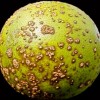 El cancro cítrico es una enfermedad introducida en Florida y es muy perjudicial económicamente para la industria comercial. La enfermedad no está presente en todas las regiones tropicales y subtropicales productoras de cítricos donde el cancro cítrico puede ser problemático, por lo tanto, las restricciones para exportar fruta con cancro cítrico son muy estrictas. Esta enfermedad también concierne a los propietarios, no solo por sus efectos en la industria económica, sino también porque es altamente contagiosa y la mayoría de la fruta contagiada en un árbol muy afectado se cae de éste prematuramente. This 4-page fact sheet was written by M. M. Dewdney, P. D. Roberts, J. H. Graham, K. R. Chung, and M. Zekri, and published by the UF Department of Plant Pathology, January 2013.
El cancro cítrico es una enfermedad introducida en Florida y es muy perjudicial económicamente para la industria comercial. La enfermedad no está presente en todas las regiones tropicales y subtropicales productoras de cítricos donde el cancro cítrico puede ser problemático, por lo tanto, las restricciones para exportar fruta con cancro cítrico son muy estrictas. Esta enfermedad también concierne a los propietarios, no solo por sus efectos en la industria económica, sino también porque es altamente contagiosa y la mayoría de la fruta contagiada en un árbol muy afectado se cae de éste prematuramente. This 4-page fact sheet was written by M. M. Dewdney, P. D. Roberts, J. H. Graham, K. R. Chung, and M. Zekri, and published by the UF Department of Plant Pathology, January 2013.
http://edis.ifas.ufl.edu/pp298
Late Blight of Potato and Tomato (PP301)
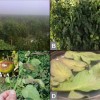 Both potato and tomato are susceptible to late blight, an aggressive disease capable of rapidly destroying entire fields. The disease is distributed worldwide and occurs wherever tomatoes or potatoes are grown and conditions favor disease development. This 4-page fact sheet was written by Ryan Donahoo and Pamela Roberts, and published by the UF Department of Plant Pathology, December 2012.
Both potato and tomato are susceptible to late blight, an aggressive disease capable of rapidly destroying entire fields. The disease is distributed worldwide and occurs wherever tomatoes or potatoes are grown and conditions favor disease development. This 4-page fact sheet was written by Ryan Donahoo and Pamela Roberts, and published by the UF Department of Plant Pathology, December 2012.
http://edis.ifas.ufl.edu/pp301
Diseases of Bitter Melon in South Florida (PP300)
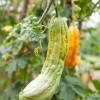 Bitter melon, a tropical and subtropical cucurbit, is widely grown in Asia, Africa, and the Caribbean for its edible fruit. Rich in vitamins A and C, iron, and phosphorus, it contains a compound (charantin) that has been used to lower blood sugar levels to treat diabetes. Two major types of bitter melon, Chinese and Indian, are grown in South Florida year-round. This publication describes common diseases and provides recommendations for their control. This 3-page fact sheet was written by Shouan Zhang, Mary Lamberts, and Gene McAvoy, and published by the UF Department of Plant Pathology, October 2012.
Bitter melon, a tropical and subtropical cucurbit, is widely grown in Asia, Africa, and the Caribbean for its edible fruit. Rich in vitamins A and C, iron, and phosphorus, it contains a compound (charantin) that has been used to lower blood sugar levels to treat diabetes. Two major types of bitter melon, Chinese and Indian, are grown in South Florida year-round. This publication describes common diseases and provides recommendations for their control. This 3-page fact sheet was written by Shouan Zhang, Mary Lamberts, and Gene McAvoy, and published by the UF Department of Plant Pathology, October 2012.
http://edis.ifas.ufl.edu/pp300
